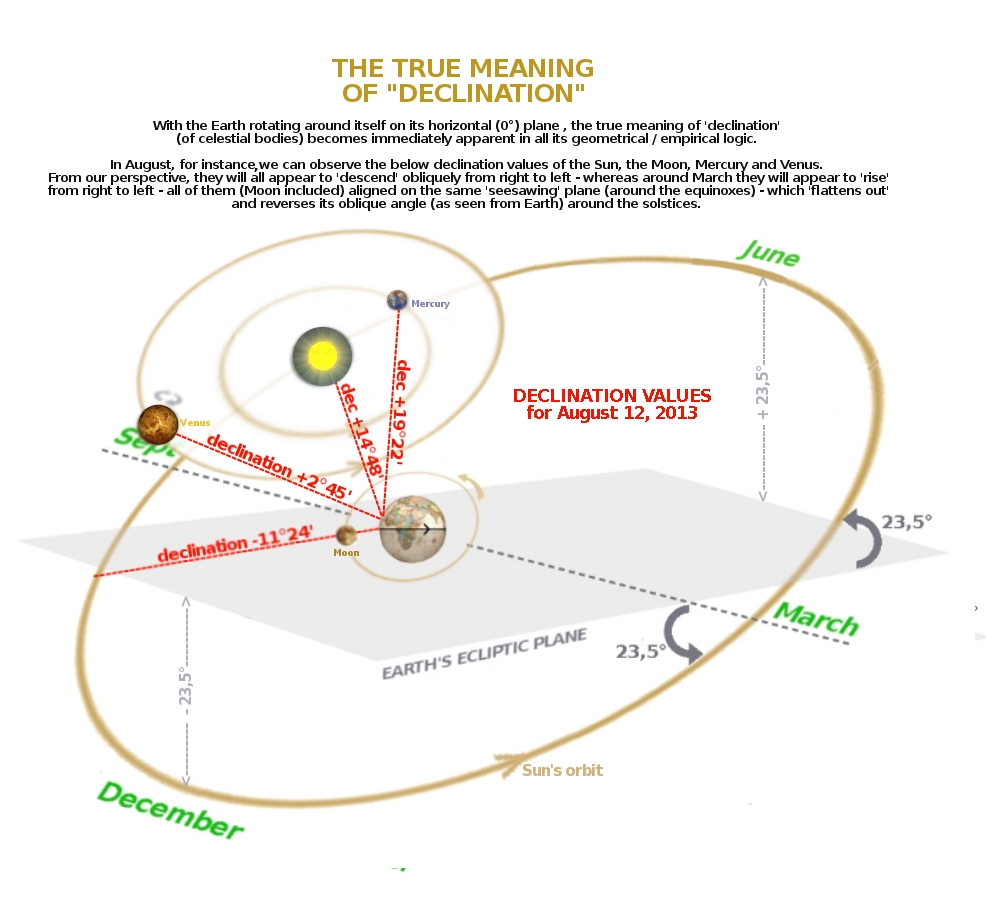agraposo wrote:
By the way, Simon, in your diagram should "Earth's ecliptic plane" read "Earth's equatorial plane" instead?
Dear Agraposo,
I chose to name it the "ecliptic plane" rather than the "equatorial plane" for a reason. In the Copernican model, the "equatorial plane" actually tilts (from our earthly perspective) by 23,5° one way and 23,5° the other (between the solstices). In my model, the equatorial plane is nothing but the Earth's ecliptic - stable throughout the years at 0°. To be sure, it is not a simple change in perspective from the Copernican model. The Earth is not the tilted object. What tilts back and forth (from our earthly perspective) is most obviously the (nearly) common / identical orbital
plane of ALL of our surrounding celestial bodies (the Sun, the Moon, Mercury, Venus, etc). The Copernican contention that the EARTH is tilted by 23,5° simply does not add up with the trajectories of these celestial bodies which we can observe from Earth.
Now, if you are under the common assumption that the Equator is a line over which the Sun always passes straight overhead, think again - as this is just a popular myth.
To see this with your own eyes, let me guide you to how the
NEAVE INTERACTIVE PLANETARIUM will show you this fact:
1: Go to the NEAVE site and choose any location on the equator by clicking on the location button:

2: Choose a NOON timeline of any day you wish - and rotate the sky (by clicking and dragging) to find the Sun .
3: Position yourself first (and this is very important) as if you were looking
SOUTH.
4: Now, start toggling (by clicking and holding) the month-to-month function. You will see the Sun performing the "analemma" - drifting up and down on your screen, with the Sun declinations going from +23,5° (June) to -23,5°(December).
5: Next, position yourself as if you were looking
EAST - and toggle the month-to-month button. You will now see the "analemma" drifting 'horizontally' - from the left to the right of your screen! Why would that be?
Well, if you spend some time trying to visualize all this as if you were really standing at the Equator - and assuming that my SSSS model is correct, you should be able to see that it IS, in fact, correct.
I know, in order to process this in your mind, you will have to appeal to your very best senses for spatial perspective. It's hard work indeed! Yet, once you 'get it', it should all become quite obvious to you. And no, these observations can NOT be made (and will NOT be equivalent) under the frame of reference and planetary motions as proposed by the Copernican model.
lux wrote:OK, so the Earth is not moving in a small, circular path then.
Dear Lux,
I have tried to explain (probably poorly so) why my initial premise of the SSSS included this small orbit of the Earth in front of the Sun. It was a mistake which I proudly admit - as I believe it was an important and necessary 'step' to take (for my mind as well as yours - and anyone else's) to overcome the aberrations of the Copernican model. If you will, we could call this a 'reverse-engineering' of sorts, where gradual steps/ phases are needed in order to break down common, die-hard assumptions / dogmas related to our solar system's configuration (as 'definitively established', for some unfathomable reason, by Copernicus and a few other folks 400 years ago). At the time, there was a RAGING debate as to Tycho Brahe's geo-heliocentric model and the new, Keplerian and Copernican models. Galileo himself was evidently confused and didn't even know which side to take - as his writings betray. All in all, there is absolutely NOTHING STRANGE in arguing that the Sun orbits the Earth - and not vice versa. I now believe to have presented strong evidence to back up this claim - and anyone is free to evaluate its validity.















